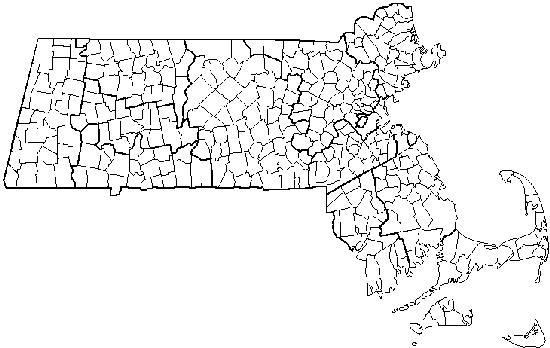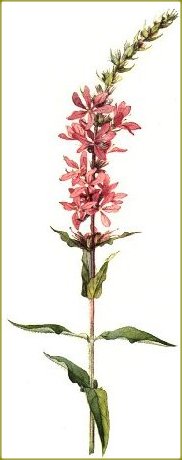
 Few
people in the continental United States can say that they've never seen
Lythrum salicaria. The bright purple flowers of this invasive
species bloom profusely during the summer, and the plants form great stands
across wetland areas. Purple Loosestrife was first introduced into
the United States in the early 19th century, and has been enjoying great
prosperity ever since. Apparently this plant was introduced through
several different vectors, as different sources attribute the introduction
to differnt factors, including herbal uses, accidental introduction via
ship's ballast (Malecki
et al. 1993), as a food source for bees (pollen), as a garden ornamental
(Thompson et al. 1987), and in wool-waste
(Committee on the Boston Flora 1907-1924).
Few
people in the continental United States can say that they've never seen
Lythrum salicaria. The bright purple flowers of this invasive
species bloom profusely during the summer, and the plants form great stands
across wetland areas. Purple Loosestrife was first introduced into
the United States in the early 19th century, and has been enjoying great
prosperity ever since. Apparently this plant was introduced through
several different vectors, as different sources attribute the introduction
to differnt factors, including herbal uses, accidental introduction via
ship's ballast (Malecki
et al. 1993), as a food source for bees (pollen), as a garden ornamental
(Thompson et al. 1987), and in wool-waste
(Committee on the Boston Flora 1907-1924).
There are several reasons that Lythrum salicaria has been such a successful invasive species. One is the ability for massive seed production, with a single plant often producing over one million seeds! The resulting seedlings will grow in a dense mat in the area surrounding the parent plant, crowding out neighboring species in the process. Also, Purple Loosestrife resprouts easily when cut, and can reproduce vegetatively. These factors, taken into account with the lack of natural enemies that might browse on the foliage or destroy roots, make Loosestrife a formidable opponent in wetland ecosystems (Malecki et al. 1993).
What does all this mean for the ecosystems that L. salicaria invades? Diverse native plant communities have been replaced by large populations of a single species, resulting in a loss of biodiversity and threatening rare plants. Wildlife that depend on these native plant communities are now also at risk. Purple Loosestrife also fills in areas of open water, threatening the habitats of waterfowl. (Stein and Flack 1996).
As you can see from the animated image below, Lythrum salicaria first started showing up in the published flora in the mid-1800's, in areas along the coastline (Bristol County, Essex County), possibly due to introduction through ballast. By the late 1800's it was probably already well-established in all of the Massachusetts counties along the Atlantic coast; the late records for Plymouth and Barnstable counties are merely a reflection of when the earliest published flora were compiled.
Purple Loosestrife is just another example of a non-native plant species
whose invasive potential has only recently been realized, even though the
species was introduced over a century ago. The links at the bottom
of this page will point you to more information about how people are handling
this invasive plant. There are even experiments currently underway
to test the ability of a beetle from L. salicaria's native habitat
to control the plant here in the United States (Malecki
et al. 1993). For now, we can all do our part by refusing to
buy and plant Purple Loosestrife in our gardens (Recent
evidence has indicated that garden varieties of Loosestrife can hybridize
with Lythrum salicaria and therefore contribute further to the problems
caused by that species), and by making sure that if we are trekking through
wetland habitats, our bodies and our clothing do not become vectors for
the spread of this species' seeds.
